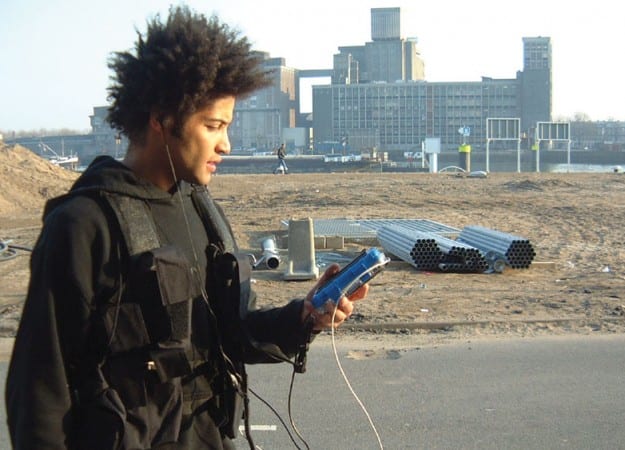Unknown image title from Blast Theory (2015)
How does their final performance relate to space? The past?
Relates to the space by creating an interactive map online to replicate that space as well has having the performers interactive with the busy city, live, by running through it.
Relates to the past by relating to each individual audience member’s past by making them remember a name of someone close to them which they have not heard for in a while. They do this twice, once when signing up and once when “caught”, making them remember memories of the person linking to their personal history.
How does architecture / archaeology relate to the choices made by the artists?
The map that they make for online audiences are based from the real life space but edits are made. There are advantages and disadvantages for both online players/ audience and the runners/ performers. For example, depending on how small the streets are/ how tall the buildings, are the runners might not get any GPS signals, therefore creating pockets where the runners cannot get them at certain points of the day. One for the performers’ advantages include being able to draw the player/audience into large open spaces by working together with other runners/performers to increase their chance of success.
How does the work position the audience / spectator in relation to creating meaning?
The audience is split in two, one audience is online and the other is the passers-by in the city where the chase takes place.
The online audience can be anywhere in the world creating a team of multilingual / cultural people who are working together towards a communal goal which is not getting caught. By placing these audiences so far away from the physical performances but linking them in via a representative map and live audio, certain feeling are created in these audience members. For example, one audience member has said “I had a definite heart stopping moment when my concerns suddenly switched from desperately trying to escape, to desperately hoping that the runner chasing me had not been run over by a reversing truck (that’s what it sounded like had happened).” (Blast Theory 2015)
It creates an interesting dynamic between audience and performer as you feel connected to the runner as they are the ones that are allowing you to experience this performance and you feel responsible for someone’s actions, sometimes a whole world away, because they were chasing you.
This has been noted and problematized in academic literate, including “A critical study of physical participation in Blast Theory’s Can You See Me Now?” by Piotr Woycicki.
“The game has been criticised for inducing a sense of military manipulation, due to its use of surveillance and the possibility of manipulating runners into risky situations (Benford and Giannachi 2011)… This notion again emphasises a discrepancy between a virtual non-consequential simulation and the real world, with the position of a potentially irresponsible voyeur on one side and that of a real witness implicated in an event.” (Woycicki, 2014, 201).
This emphasises the emotional and physical control both player/audience and performer/runner, have over each other as the game/performance progresses highlighting ethical issues of when is it ok to hold that much power over a person.
For the passers-by on the street all they see is people all dressed in black, military/ runner gear, running past them in the street speaking into a walkie talkie. Without any prior knowledge this creates an interesting dynamic with the space. The streets, which to them are completely ordinary, suddenly turn into something exciting and strange, allowing them to pay more attention to what happens in their city everyday which they may not have experienced before.
How does the work get documented?
In one of the more recent versions of the “game”, you can access the “installation shows early versions of the web interface for the game, video documentation of the work and a three screen projection. The projection is an interactive recording of an entire game of Can You See Me Now? You can follow individual players, watch from above or explore alone as the game unfolds.” (Blast Theory, 2015) You can only view the installations if the game/ performance is on. If a game is in progress you can also join in as long as you have the correct computer/ internet access.
How do we have access to it?
If a game is in progress you can also join in as long as you have the correct computer/ internet access.
Cite List
Blast Theory (2015) CAN YOU SEE ME NOW. [Online] Blast Theory. Available from http://www.blasttheory.co.uk/projects/can-you-see-me-now/ [Accessed 4 March 2015].
Blast Theory (2015) CAN YOU SEE ME NOW? – INSTALLATION. [Online] Blast Theory. Available from http://www.blasttheory.co.uk/projects/can-you-see-me-now-installation/[Accessed 4 March 2015].
Woycicki, P. (2014) A critical study of physical participation in Blast Theory’s Can You See Me Now?. International Journal of Performance Arts and Digital Media. 10 (2) 193–204.
